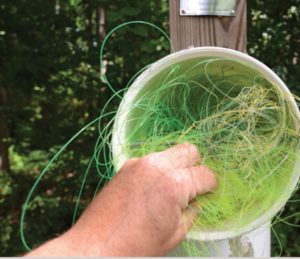Fishing is a key component of the Florida lifestyle as well as the state’s economy. But fishing line and other fishing tackle frequently enter Florida’s aquatic systems as a result of incidental snags or improper disposal. When left in the aquatic environment, fishing line and tackle create potential traps for unsuspecting wildlife that can become entangled and snared, leading to injury and death. Monofilament is the most common type of fishing line; however, modern advances have produced several other varieties with higher tensile strength, reduced visibility, and greater abrasion resistance. These newer, non-monofilament lines, such as braid and fluorocarbon, are fairly popular but not all of them can be recycled like monofilament fishing line, and they are commonly disposed of improperly.
To help reduce the negative environmental impacts from improper disposal of all fishing line and tackle, anglers can follow these general guidelines:
- Check line frequently for frays that may break easily. • Don’t leave bait unattended since pelicans, herons and other birds may attempt to take the bait from the line, which may result in entanglements.
- Cast away from trees, utility lines, wildlife and areas where line may get caught.
- If you see improperly discarded fishing line while you are out, pick it up and stow it to be disposed of later.
 Anglers can also purchase or make their own fishing line storage bins to keep with them while they are fishing so that line can be stored securely and out of the way. Products such as the Monomaster and Line Snatcher are designed to help anglers store their unwanted fishing line; however, homemade versions can also be made by cutting an “X” in the lid of something as simple as a tennis ball container or coffee can. Once on shore, monofilament and fluorocarbon line can be recycled in designated bins found at most boat ramps, piers and tackle shops. However, anglers should not use these bins to discard any other type of fishing line or leader material such as braid or wire. Also, the bins should not be used to discard any type of tackle, such as hooks, lures or soft plastics, which can injure other anglers discarding their fishing line or the individuals who empty the bins for recycling.
Anglers can also purchase or make their own fishing line storage bins to keep with them while they are fishing so that line can be stored securely and out of the way. Products such as the Monomaster and Line Snatcher are designed to help anglers store their unwanted fishing line; however, homemade versions can also be made by cutting an “X” in the lid of something as simple as a tennis ball container or coffee can. Once on shore, monofilament and fluorocarbon line can be recycled in designated bins found at most boat ramps, piers and tackle shops. However, anglers should not use these bins to discard any other type of fishing line or leader material such as braid or wire. Also, the bins should not be used to discard any type of tackle, such as hooks, lures or soft plastics, which can injure other anglers discarding their fishing line or the individuals who empty the bins for recycling.
You can learn how to make your own monofilament recycling bin by visiting our FWC Saltwater Fishing YouTube channel or by participating in the statewide Monofilament Recovery & Recycling Program. For more information on the statewide Monofilament Recovery & Recycling Program, visit mrrp.myfwc.com. In addition to properly securing and recycling monofilament and fluorocarbon line, it is important to ensure that non-monofilament line and other tackle are disposed of appropriately. To discard non-monofilament line, such as braid or wire, cut the line into 12-inch or smaller pieces and place into a covered trash receptacle. Line placed in trash receptacles without lids can blow out into the environment or entangle wildlife that are foraging in the open trash receptacle. When disposing of other tackle, such as hooks and lures, it is important to clip off sharp points to avoid injuring humans and wildlife that may come in contact with the discarded tackle. As part of the “Pitch It” campaign, soft plastic baits with the hook or jig head removed can be discarded in special program containers that are separate from monofilament recycling bins. Learn more about soft bait disposal and the “Pitch It” campaign by visiting pledgetopitchit.org.
Remember, disposing of fishing line and tackle appropriately can reduce the risk of wildlife entanglement and help protect coastal habitats. To learn more about bird entanglement and how to unhook a bird, visit myfwc.com/unhook. To report entanglement of protected species, such as manatees and marine turtles, call the FWC Wildlife Alert Hotline at 888-404-3922 or dial *FWC on a cellphone. Have a burning question about marine fisheries regulations? Want to know more about catch-and-release? We are here for you. Send your questions, photos and fishing tales to . Make sure your photo meets our photo requirements by visiting myfwc.com/ fishing and clicking on “Saltwater Fishing” and “Submit a photograph” under “Get Involved.” Don’t forget to record all of your catches on the iAngler phone app or at snookfoundation.org. And learn how to submit your catches and get rewarded through our Saltwater Angler Recognition Programs at catchafloridamemory.com. Jill Christopherson, Florida Fish and Wildlife Conservation Commission

Would you write another content about `Braided Fishing Line` or if you have any experience with this share with us. I am looking for more info about Braided Fishing Line. Thanks